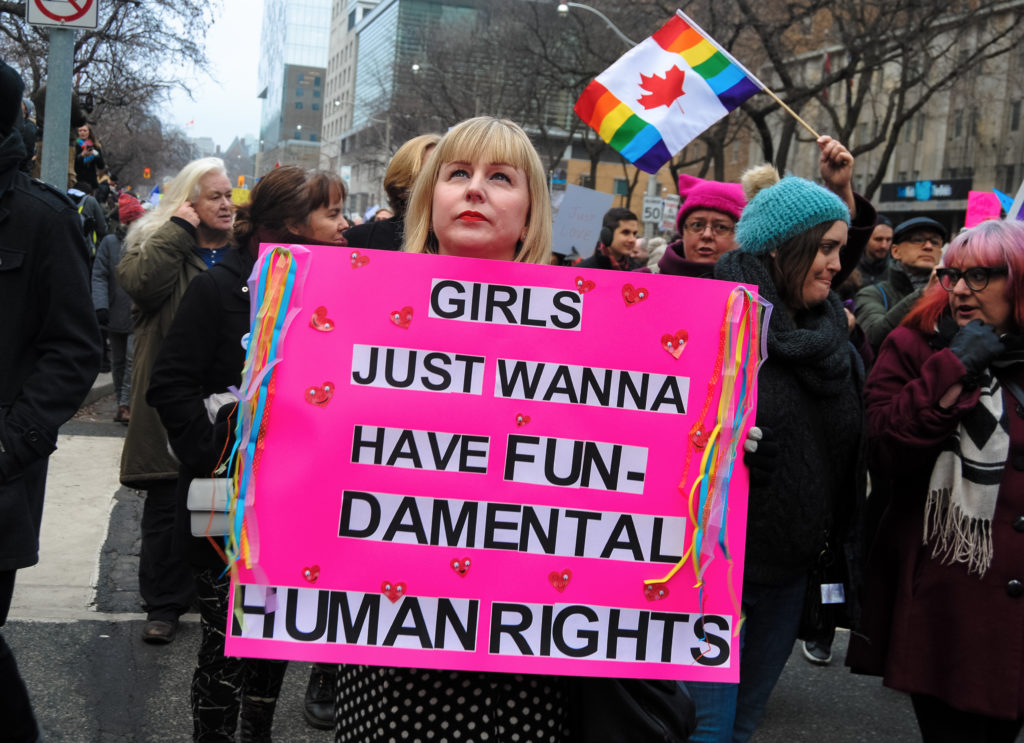Today is 108th anniversary of International Women’s Day. This June 4th will mark the centennial of congress voting to give women the right to vote by passing the 19th amendment, which was ratified and written into law on August 18, 1920. And yet, the Equal Rights Amendment (ERA) has been languishing in limbo since 1972. Recent efforts to gain the 38 state majority required for ratification by implementing the “Three State Strategy” have moved forward the ERA, and as it currently stands, only one more state is needed. Of course, even that depends on who you ask since the deadline for ratification expired, first in 1979, though it was extended to 1982 and still failed to be ratified.

[Wikimedia Commons]
U.S. statehouses across country have introduced some of the most oppressive and regressive laws imaginable in the past few years that have the potential to negatively affect women’s reproductive right in a variety of ways. The current administration’s stance on immigration is tied to this, as the largest demographic of migrants last November was families—mostly women and children.
The levels of misogyny and racism in the U.S. have been exposed over the last few years in ways that have caught a lot of people off-guard, and by people I mean mostly white people. A woman today is better off in many ways than she was 30 years ago, but equal? Hardly.
Women’s rights are human rights. Worldwide there are numerous countries where atrocities happen daily. Imagine that because your dowry was deemed too low and an insult, your betrothed and his family poured gasoline on you and set you ablaze.
And that is just one example. Women are incarcerated, and murdered in other countries for things we rarely think about in the U.S. A cursory examination of the history of laws in the U.S. shows how women have fought over and over again for rights bestowed on the average white male by virtue of being born male. While women can legally own property, enjoy an alcoholic beverage alone in a public establishment, serve on a jury, become doctors, lawyers, and even serve in the office of government, we are still on average paid 4% less than our male counterparts.
The pay disparity is just the most obvious and visible sign of discrimination. The medical arena is the possibly the next most obvious where routine discrimination is on display. Any woman who makes the conscious choice to not reproduce and is under the age of 35 will have to search to find a doctor who will agree to do a tubal ligation, even when she has health issues that indicate carrying a pregnancy to term might be a death sentence. For decades, women complaining of physical issues were told it was all in their head, and prescribed a sedative. Only recently has research been disseminated to the general public pointing out that the warning signs for a heart attack present completely different in women than they do in men.
The pharmaceuticals in development generally focus their studies on men. Again, only recently have pharmaceuticals been re-evaluated in dosage when it comes to women. Most still do not take gender into account when making recommendations on dosage. These are just a few, obvious examples of how women are not just treated differently, but in some cases ignored all together.
We can cheer on the movies like Wonder Woman and Captain Marvel that feature women not as just a sidekick or peripheral character but in leading and complex roles. We can celebrate the historic number of diverse women elected to Congress in 2018. Sure, both of these things are great and important. On average though, women still face some of the toughest situations and challenges in society.

State Street Global Advisors Calls on 3,500 Companies Representing More Than $30 Trillion in Market Capitalization to Increase Number of Women on Corporate Boards [Photo: Business Wire]
The stigma of being a single parent is much less than it was even 20 year ago, but the challenges remain and in some cases are even greater. Never mind the disparity between white women and women of colour, which remains a huge gap. Roughly 80% of custodial parents are women, and yet women are paid less, and only about half receive the child support they are due.
Then there is the violence directed at women. The numbers are appalling. The World Health Organization (WHO) estimates one in three women worldwide have been assaulted. I say “estimates” because a majority of assaults, especially sexual assaults, go unreported. The number of women murdered globally in 2018 was around 87,000. That’s 238 each day, almost 10 women an hour, one woman every six minutes. Over 50,000 (58%) of those murders were committed by a family member or “loved ones” as the perpetrator.
Women make up more than 50% of the population, yet we continue to struggle to find a cohesive and inclusive voice. It shouldn’t take decades for women, like Katharine Johnson, Dorothy Vaughan, and Mary Jackson to be recognized for their work. U.S. history is littered with women who excelled and still remain unrecognized for their amazing work. In the Pagan sphere we have only to look to Pamela Coleman Smith, the artist who created the illustrations for the Rider-Waite/Waite-Smith tarot deck. It only took about a hundred years for her work to be fully recognized.
If, as women, we want real equality, we will have to continue to fight for it. And we need all the allies we can muster.
The Wild Hunt is not responsible for links to external content.
To join a conversation on this post:
Visit our The Wild Hunt subreddit! Point your favorite browser to https://www.reddit.com/r/The_Wild_Hunt_News/, then click “JOIN”. Make sure to click the bell, too, to be notified of new articles posted to our subreddit.